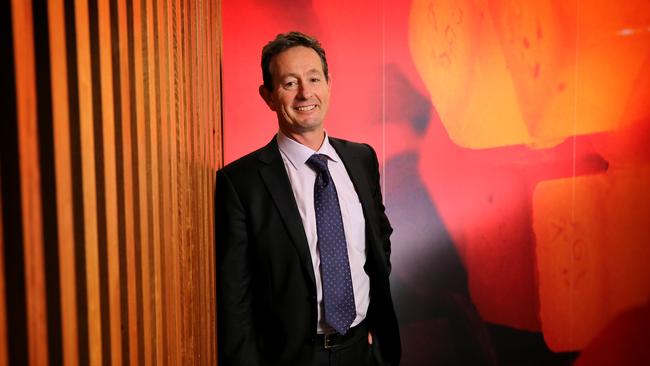Orica operations chief Alberto Calderon knows the drill
When Orica chose an oil and gas drilling executive to head the AP explosives business, it was a move from left field.

When Orica chief executive Alberto Calderon chose an oil and gas drilling executive to be his new head of the Australia-Pacific explosives business last year, it looked like a move from out of left field.
Angus Melbourne, an Australian working mostly overseas for the past 25 years for the globe’s biggest oilfield services company Schlumberger, was the new executive charged with overseeing the local operations of Orica, which chiefly provide explosives and blasting services to the mining industry.
Now, with nine months’ experience in the explosives and mining business under his belt, Melbourne, 51, has been promoted to a senior position as Singapore-based chief commercial officer, with responsibility for marketing and technology.
And Mr Calderon’s plans to use the oil services executive’s experience at the pointy end of innovation in the US shale oil and gas revolution, where the industry has made incredible progress in technology and productivity, are becoming clearer.
“I see a similar opportunity (to use technology to boost performance) in the drill and blast space,” Mr Melbourne told The Australian from Orica’s Melbourne head-office before taking up his new position.
Talks around using his Schlumberger experience to implement Orica’s strategy began soon after Mr Calderon became the official, rather than acting, managing director in May last year.
“I met Alberto in the middle of last year and we started a conversation around how we could bring technology to bear on Orica’s business with my background in technology and running businesses,” Mr Melbourne said.
Mr Calderon, a former BHP Billiton senior executive, had previously stressed that Orica’s relationships with its mining customers were not up to scratch and that there was no major technological focus at the customer service level once a contract had been signed.
The creation of the new chief operating officer position, which will integrate commercial, technology and marketing, is a key driver of Calderon’s strategy to change the way the company serves customers.
The move also sets Melbourne up as a candidate to succeed Calderon, who was a non-executive director at Orica before taking on the acting managing director role in the wake of the sudden exit of Ian Smith in March last year. The US shale boom that is now providing ideas for Orica appeared on the radar of most Australians from around 2011, when US oil production began to accelerate.
But it had been building for nearly a decade.
Its chief drivers, hydraulic fracking and horizontal drilling, were not new. But when combined, and over time perfected, they again turned the US into the world’s biggest oil producer, taking back the mantle, at least temporarily, from Saudi Arabia.
Mr Melbourne spent the previous seven years with Schlumberger in Asia and before that spent three years in Houston, including as head of oil and gas well completion technology.
He said the tipping point for US shale came when technological advances meant measurements of ground that long horizontal wells were drilling through could be made as the well was drilled, meaning the drill bit could be steered exactly where it needed to go.
And this is one area where Orica could benefit. “In the drill and blast space today, we take these fairly sophisticated (mine and blast) models and manually apply them on the (mine) bench,” Mr Melbourne said.
“If you can use the information in real time to measure fragmentation in situ, then optimise for the next blast, then you can drive better outcomes.”
This meant that less coal would be destroyed in the blast, or that mineral ore could be more easily dug and processed, both meaning better productivity for customers.
The potential productivity benefits are big, Mr Melbourne said, including the ability to improve mill throughput by up to 10 per cent and shovel productivity up to 20 per cent.
Another area that Mr Melbourne said the explosives world could learn from the oil and gas drillers is a Schlumberger-pioneered move from a very fragmented model that used lots of service providers to one that was completed integrated. “It has halved drilling times,” he said.
The new structure puts Orica’s technology leadership under the same group as the customer-focused marketing section.
“We’re looking at bringing new technology to market faster and bringing more efficient and applicable technology to our business,” Mr Melbourne said.
“Our customers have done a fantastic job cutting costs, but you can only cut so many costs and we are not moving to a period where they will have to focus on productivity and driving more value out of assets, which I think plays to Orica’s strengths.
One of the reasons Mr Melbourne took the Orica job was to bring his Australian wife and three daughters back to Australia after a 25-year career that saw them living in nine countries.
Mr Melbourne joined Schlumberger after finishing an engineering degree at Monash University, swayed, he said, by the promise of adventure in far-flung places.
“It turned out to be pretty accurate — a few months later I was in the jungle in Sumatra on a remote well site,” he said.
Starting as a wireline field engineer with a local crew of three, Mr Melbourne spent weeks in the jungle running surveys and repairing sensitive equipment.
He was then moved to running operations and after that put in a research and development role.

To join the conversation, please log in. Don't have an account? Register
Join the conversation, you are commenting as Logout